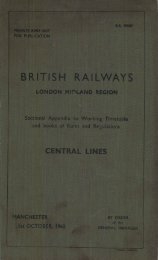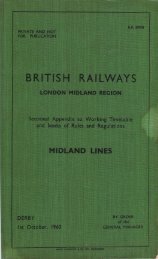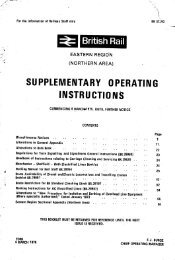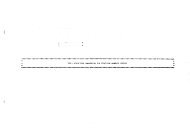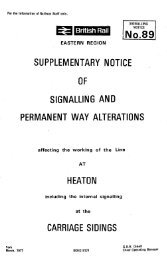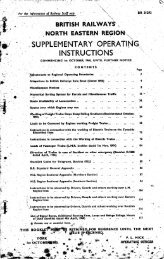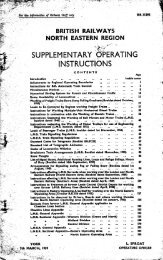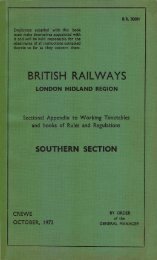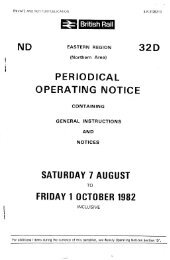general instructions. - Limit Of Shunt
general instructions. - Limit Of Shunt
general instructions. - Limit Of Shunt
You also want an ePaper? Increase the reach of your titles
YUMPU automatically turns print PDFs into web optimized ePapers that Google loves.
General Onstructions.—Continued. 1 2 7<br />
General Instructions in regard to Continuous Brakes.<br />
General Rules 165 and 206.<br />
the passenger trains of this Company, must be fitted with the<br />
Westinghouse Continuous Brake, subject only to the following modifications<br />
and exceptions :—<br />
In the case of a train running a distance of not more than 10 miles without<br />
stopping, unbraked vehicles in the proportion of one in four, and in<br />
the case of a train running a distance exceeding 10 miles without<br />
stopping, unbraked vehicles in the proportion of 1 in 6, may be<br />
attached, but all such vehicles must be fitted with the through pipe<br />
of the pattern in use on the train.<br />
For the purpose of calculating the number of vehicles of which a train is<br />
composed, the following table must be observed :—<br />
Engine, including tankengine<br />
(if wheels fitted<br />
with continuous brake) as 2 vehicles.<br />
Tender a s 1 vehicle.<br />
Eight (or more) wheeled<br />
Carriage a s 2 vehicles.<br />
Six-wheeled vehicle a s 1 vehicle.<br />
Four-wheeled vehicle<br />
(conveying passengers) as 1 vehicle..<br />
Horse Box<br />
Carriage Truck<br />
Fish Truck, Van, or other<br />
four-wheeled vehicle,<br />
not conveying passengers<br />
as -/ vehicle..<br />
2.—All vehicles for the North Eastern line received from Companies using<br />
brakes other than the Westinghouse should be fitted with the Westinghouse.<br />
brake or through pipe as set forth in paragraph 1.<br />
The exceptions to this rule are :—<br />
(a) In the case of special trains which are worked throughout by the.<br />
Owning Company.<br />
(b) When arrangements have previously been -<br />
made<br />
N.E.<br />
f o<br />
engine.<br />
r s<br />
fitted<br />
u p<br />
with<br />
p l<br />
the<br />
y i<br />
Vacuum<br />
n g<br />
brake.<br />
In the a event , of Foreign Companies sending vehicles to the N.E. line not<br />
fitted with the Westinghouse Continuous Brake or through pipe as provided,<br />
for in these Regulations, the traffic must be transhipped into properly fitted,<br />
vehicles, and the circumstances reported to the District Superintendent by<br />
the Station Master at the Junction Station.<br />
For list of the principal Companies using the Westinghouse and Vacuum,<br />
Automatic Brakes, see page 126.<br />
3.—When the van is the rear vehicle the Guard must test the brake in theordinary<br />
way as prescribed in clause 12 of Book of Regulations for working<br />
the Westinghouse Automatic Brake.<br />
4.—When the Van is in any other position than at the rear end of the.<br />
train, the guard must test the brake by opening the tap outside the rearmost<br />
end of the last vehicle on the train. Before opening this tap he must<br />
inform the Driver, in the case of trains fitted with the Westinghouse Brake,<br />
that he is going to test the .brake, and then carefully observe the pressure<br />
registered on the gauge in the rear van. After satisfying himself that the<br />
indicator shews that a reduction of not less than 10 lbs. has taken place,<br />
the Driver must be informed and the pressure restored in the usual way.<br />
5.—In the case of a train on which the Vacuum brake is being worked, when<br />
the van is in any other position than at the rear of the train, the guard must,<br />
before making the test in accordance with clause 13 of the Instructions for<br />
working the Vacuum brake, satisfy himself that the brake pipes are properly'<br />
coupled up between the whole of the vehicles, and that the flexible connection<br />
at the rear of the last vehicle is properly secured on the dummy plug.




